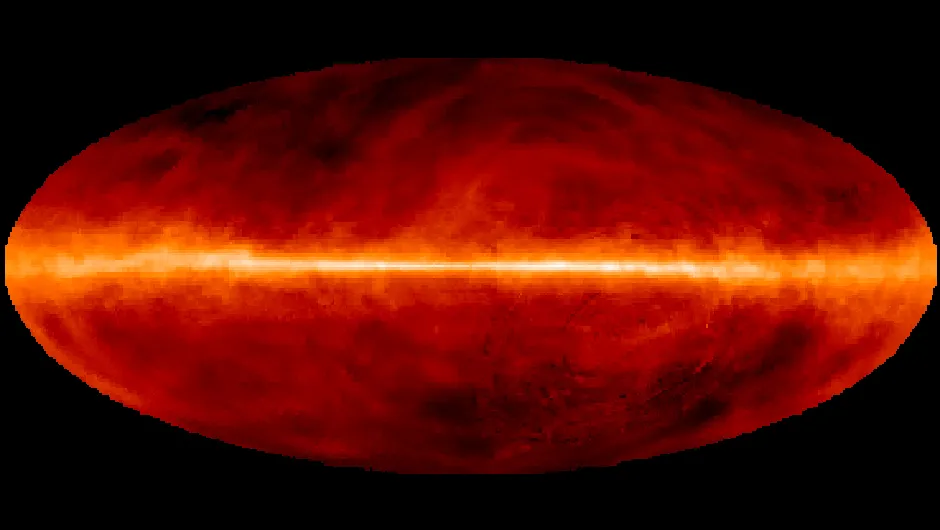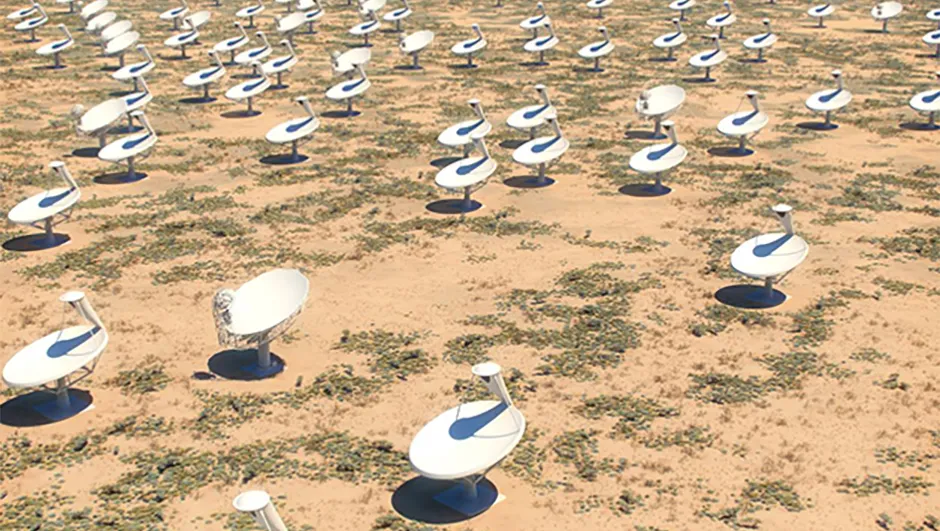The elliptical galaxy Hercules A looks ordinary in the visible spectrum (the white central light). However, using the VLA radio telescope, spectacular jets powered by the gravitational energy of a supermassive black hole can be seen (red). Image Credit: NASA/ESA/S.Baum and C.O’Dea (RIT)/R.Perley and W.Cotton (NRAO/AUI/NSF)/Hubble Heritage Team (STScI/AURA)
Written by Nadia Blackshaw
The 21st century will probably go down in history as the time when smart devices burst onto the market.
Most people now have a smartphone, but more and more devices are becoming 'smart' or getting connected.
The future seems to be heading towards the ‘internet of things’ where your oven will turn off when it detects you’ve forgotten about dinner and your bath can monitor your blood pressure.
This might sound amazing, but the growing market of devices is also affecting an integral part of space science.
Radio astronomy observes space at radio frequencies; a range from 3kHz to 300GHz.
It is useful for astronomers because many celestial objects emit radio waves and so analysis of these signals might reveal new ‘dark’ galaxies, gas ejecting black holes or even alien messages.

Radio waves allow us to observe hydrogen gas, the most abundant element in the Universe, and communicate with space probes exploring the Solar System and beyond.
Radio astronomy already has some protection from mainstream broadcasting, as many international telecommunications unions have allocated specific frequency bands just for radio astronomy.
These different bands fall in the region 13.36-1427MHz and correspond to different types of signals from space that astronomers search for.
Probably the most protected of these is 1400-1427MHz, the band range for hydrogen measurements.
Is it a galaxy? Is it a pulsar? No, it’s your microwave!
However, even with multiple secure frequencies, problems still occur due to everyday radio broadcasting and growing numbers of smart devices.
An example of this occurred at theParkes Observatoryin New South Wales, Australia, which had been detecting mysterious bursts of radiation coming from space since 1998.
The signal seemed to randomly appear, and it was only in 2015 that the source was found.
It was in fact a microwave oven that was used by staff to heat up their lunch.
The reason it took so long to be identified was that the interference was only seen when the door was opened before the timer went off, and with the telescope pointing in the right direction.
There are two main sources of radio frequency interferences (which include your microwave!); ground-based and satellite-based.
Ground-based radio emissions can unintentionally broadcast at neighbouring frequencies or produce harmonics, which are integer (whole number) multiples of the original frequency.
These harmonics appear in other bands and can appear and cause interference within the restricted regions.
Due to the limitations on the waveband, the frequencies designated for radio astronomy lie very close to, or even neighbour much stronger signals for mobile phones or television.
The signals from space are very weak in comparison to these earthly interferences and so any leakage into a restricted band from bordering sources could mean loss of valuable scientific data.
“Any portion of the radio spectrum that is used less [by consumers] in order to enable radio astronomy is extremely welcome, and it gives us some windows we wouldn’t otherwise have,” says Robert Braun, Science Director for the Square Kilometre Array (SKA).
“But unfortunately, nature can’t be put into little boxes.”
Although the secure airwaves are useful, they can’t cover everything.
Protected regions often allow for clear observation of signals from our own Galaxy, but as signals travel from distant sources their frequency decreases, sometimes shifting out of the restricted bandwidths.
“What this means is the hydrogen emission from those earliest moments when the Universe first became visible, first became illuminated by stars, sits right on top of the FM radio band as seen from the Earth.
That makes it really inconvenient,” continues Braun.
While scientists have found techniques to avoid most ground-based interference, satellites offer another problem.
They can cause high levels of interference and are sometimes harder to avoid due to their orbits.
Signals are most affected by low and medium Earth orbit satellites, which don’t maintain a steady position in relation to Earth like geostationary ones.
Therefore, it is harder to track where interfering signals could come from and so complex software is required.
Even economics looks set to play a role in the future.
As more devices are used and manufactured, and people look to completely connect their home, the demand for better transmission increases.
In March 2016, mobile phone broadcasters in the US bought 84MHz of unused television airspace in a $19 billion auction, showing the vast economic demand for bandwidths within the consumer market.
At the moment there has been no obvious push from companies to reduce restricted regions set aside for research, but as use increases this could change.
The key to the puzzle
Scientists thrive at finding solutions to problems and radio astronomers are no different.
Their first solution to avoid stray signals is to move away from them.
Radio quiet zones are the new breeding ground for radio telescopes.
These are areas where the population density is very low so there is less radio wave usage and it is easier to control broadcasting through legislation.
The SKA Telescope (set to be built in 2018) will be located in Western Australia and South Africa, both of which fall under the definition of quiet zones.
Being located away from areas where smart phones are used and signals are being transmitted, the effect of ground-based interference is massively decreased.
It even helps with geostationary satellites that generally remain above populated areas.
However, a different technique is needed for the low and medium orbit satellites, with their changing positions in the sky.

By running complex algorithms, researchers can identify signals of a particular type and then erase them.
This is not easy due to the difficulty in pinpointing all the radio interference types for the software to recognise but it is still the most effective method.
Simply, the researchers can identify the frequency range they expect the signal from space to fall in.
All outside frequencies will then be ‘blanked’ or removed from the data.
More complex procedures include directing other receivers towards expected sources of interference.
This interference data collected is then compared with the complete data and the interferences can be removed, leaving behind only the desired signals.
By utilising complex computer programs and being based in remote areas, radio astronomers are able to remove most interference and thus observe the faint signals from space.
Looking onwards into the silence
It might seem that even with the use of quiet zones and programs to remove interference, radio astronomers have enough to worry about.
But it seems that the future might be bringing a new challenge to the game.
Technology research programs are looking to revolutionise the way our devices make use of the frequency bandwidths.
Instead of having strict allocated bands, individual devices will automatically scan the nearby bandwidth consumption and pick a frequency that has low usage at that time.
This opens up great opportunities for faster connections in the consumer sector, but will cause new problems for radio telescopes.
“Generally these sorts of schemes make it trickier because when you’re trying to train an algorithm to identify something external and excise it, then the more stable that pattern is, the more straightforward it is to identify,” says Braun.
“If it’s bouncing around in frequencies it offers an additional challenge.”

The silver lining?
Most of this technology will be used where there is high population density; areas these astronomers are already avoiding.
But new challenges the astronomers face will almost definitely lead to new innovations to solve them, technology that could find an unforeseen use in industry.
And so, as the populated world becomes noisier with smart glasses and smart socks, small pockets of it look set to become quieter than ever.
The mission: listen to the distant parts of the Universe.
The strategy: leave your phone behind.
